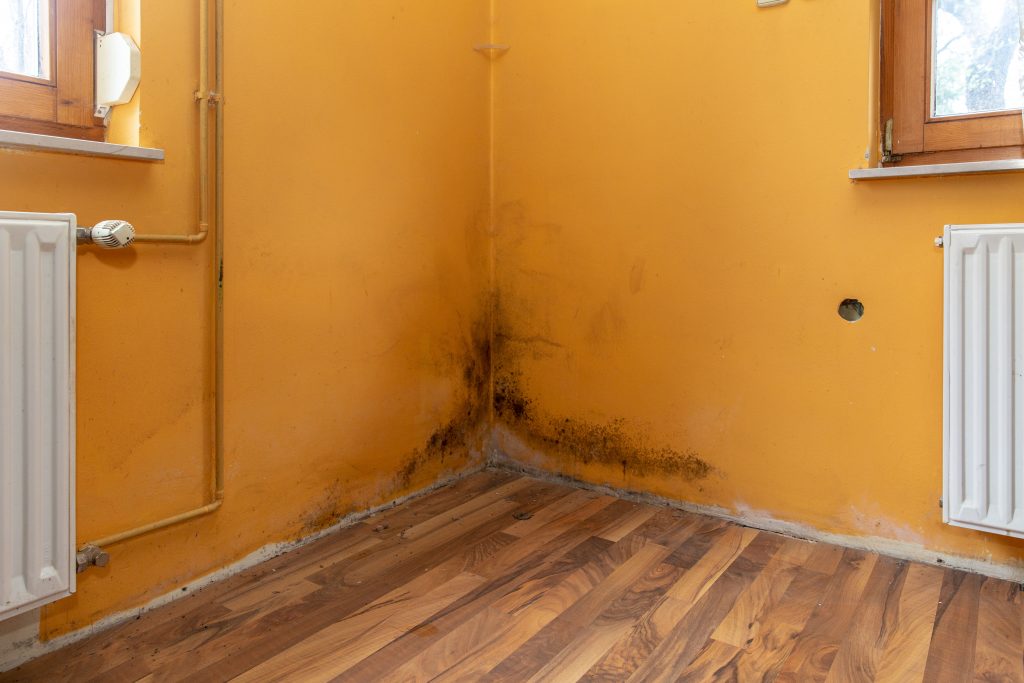How do we get rid of damp?
Ideally the earlier you can spot signs of damp within your home the easier it will be to get rid of as less damage will have occurred and it will have less of a ‘hold’ within your property. Look for clear indications on your walls, such as wet or damp patches, changing darker colours on walls, peeling wallpaper and flaking plaster. There are other signs around the house that indicate damp is present are musty smells, rotting wood such as skirting boards. Mould and mildew can be seen on walls, floors and/or ceilings.
What can I do if I find damp?
Dehumidifiers draw moisture out of the air, so can be particularly useful if you often dry clothes inside the house – another common source of excess humidity. Dehumidifiers can also help if you notice moisture in the air from everyday activities such as showering and cooking – all of which can lead to high levels of humidity. If you notice water stains on your walls or ceiling, condensation on your windows, mould spores in your shower or a general musty smell, it could be worth buying a dehumidifier.
Ventilate the property.
Condensation is the most common type of damp and is found and formed in most properties, condensation is also easy to fix. It can often be solved very quickly and at not a great cost. It can also be diagnosed without the need for a professional damp surveyor. Simply improving your home’s ventilation is the first easy step and can help clear condensation and prevent it returning. The most susceptible areas of a property are bathrooms and kitchens, these are the areas where most of the condensation is produced because of showering, bathing and cooking. Most persons and pets that live in a property will also add to the condensation issue. Best practice would be to have extractor fans in all bathrooms and kitchens to extractor the warm air out into the external environment. Trying to limit the condensation within a property is good advice.
Regularly clear your windows of condensation, so it doesn’t cause damage or develop into mould (which is a separate issue but is extremely harmful to health). You can do this easily with a towel, clothes or tissues.
Simple yet effective ways to reduce condensation are;
– Open windows regularly; especially when cooking, washing up or showering.
– Try to dry clothes outside on sunny dry days, rather than on a clothes rail indoors.
– Add window/trickle vents to the tops of window frames.
– Add air bricks into outside walls.
– Install air vents to internal walls and sealed chimneys for airflow.
– Fit roof ventilation tiles to allow air through the loft.
Check the gutters on the property
Penetrating damp is caused by water, normally rainwater, leaking through walls. This tends to happen as a result of structural with a property, such as faulty guttering or roofing, cracks in external walls, open chimney pots, damaged flashings to roofs and chimney stacks etc.
Penetrating damp can be caused by water leaking from gutters and downpipes on the outside of your home, so examine them for cracks. Fixing them could solve the problem. This is a simple fix.
Fixing penetrating damp can be easy and cheap to do yourself. It takes a little time the identify the cause, it is normally the way to ‘follow the trail’ this will help you identify the issue, you may be able to rectify the problem, if you decide this is beyond your scope of ability then you can decide if you need professional help usually from a surveyor/contractor.
The first signs normally observed of penetrating damp is usually wet or leaking walls. What to Look out for is:
– damp patches
– mould
– a discolouration of interior walls
– water droplets
– blistered plaster
– wet surfaces
Try Damp proof paint
Old bricks can become porous with time and allow water into your home. (Many properties today are over 100 years old) If this is happening, you may need to have the perished masonry chopped out and replaced. However, one easier option to try first is painting the bricks with an exterior silicone water-repellent fluid, limewash or mineral based paint. This will seal your walls again, while still allowing them to breathe, which is important. Damp-proof exterior paint can also be a good preventative measure but seek professional advice first on what would work best for your home’s age and building materials from a surveyor.
Check the property for signs of rot
Rot in timber can be a major cause of structural damage to a property and occurs primarily due to damp or poor ventilation, the rot then sets into the timber. Rot in timber can be very serious – if you suspect you have rot, you should call in specialist help. The PCA (Property Care Association) do have damp and timber specialists who will diagnose and provide details and a route to remedy the rot. Wet rot tends to grow on very wet timber where there is a constant source of moisture. It doesn’t spread through brickwork and stops growing when the source of moisture dries up. Signs of wet rot include a black fungus and timber that feels soft and spongy and is possibly discoloured. There may also be a damp, musty smell. Dry rot needs less moisture and can grow into non-timber materials, such as plaster and bricks. Signs of dry rot include white or orange growths, crumbling timber, deep cracks and a mushroom-type smell.
Check the damp-proof course on the property
Properties have different types of damp-proof courses DPCs such as PVC, bitumen or slate depending on the age of construction and some DPC because of their age and sometimes other reasons may have failed. The first thing to do if you have rising damp is to find out whether you have a (DPC) and damp-proof membrane (DPM), which should stop water from the ground soaking into ground-level walls or floors. Regulations making them compulsory in new houses came into force in 1875, so houses built before then probably won’t have a DPC and will be susceptible to rising damp. You may be able to spot a damp-proof course by looking for a thin strip near the bottom of the external wall normally 150mm or two bricks high from the ground level. You may need to get an expert to confirm this and to try to ascertain whether there is also a damp-proof membrane. If your home does have a damp-proof course or membrane but is still experiencing damp, then it may have become damaged or worn over time as mentioned above. If they aren’t working effectively, you’ll need them to be repaired or replaced, in keeping out of the property.
Repair or insert a damp-proof course
The most common remedy for a missing or damaged damp-proof course is for a builder or damp specialist to drill holes into your wall into the mortar joints between the bricks and inject damp-proof cream to act as a new course. There are alternative solutions available, such as cutting grooves into the brickwork and installing a piece of damp-proof course. This is more invasive than just drilling holes, so may be less easily hidden but can be more effective.
Repair or replace a damp-proof membrane
If there is just a small area of damp on the floor, it may be remedied by painting over the patch to stop any more water seeping through. We would advise applying two coats of bitumen latex waterproof emulsion, which can be bought from DIY stores, underneath the floor covering. For extra protection, some experts recommend laying reflective foil building paper (foil side up) before the paint is dry. This is only suitable for minor cases of damp. If the damp is extensive within the property, you may need to have the damp-proof membrane entirely replaced and this is likely to be costly operation, but unfortunately may be necessary if the damp is widespread.
Check exterior ground level
Once having inspected the exterior of the property and the DPC and it is assessed that there is a perfectly good damp-proof course in place, the damp problem could be because the ground outside has been built up above the damp-proof course, which should be 150mm above ground level. This is quite common on many properties. The problem of high ground level can be solved by digging away excess soil on the exterior side of the damp wall to below the level of the damp-proof course. You could do this yourself, or you could get a professional to do it. Installing French drains or vent box drain gully’s is great way of removing any rainwater from affected areas. To book your surveyor if you are selling or buying then get in touch today.



